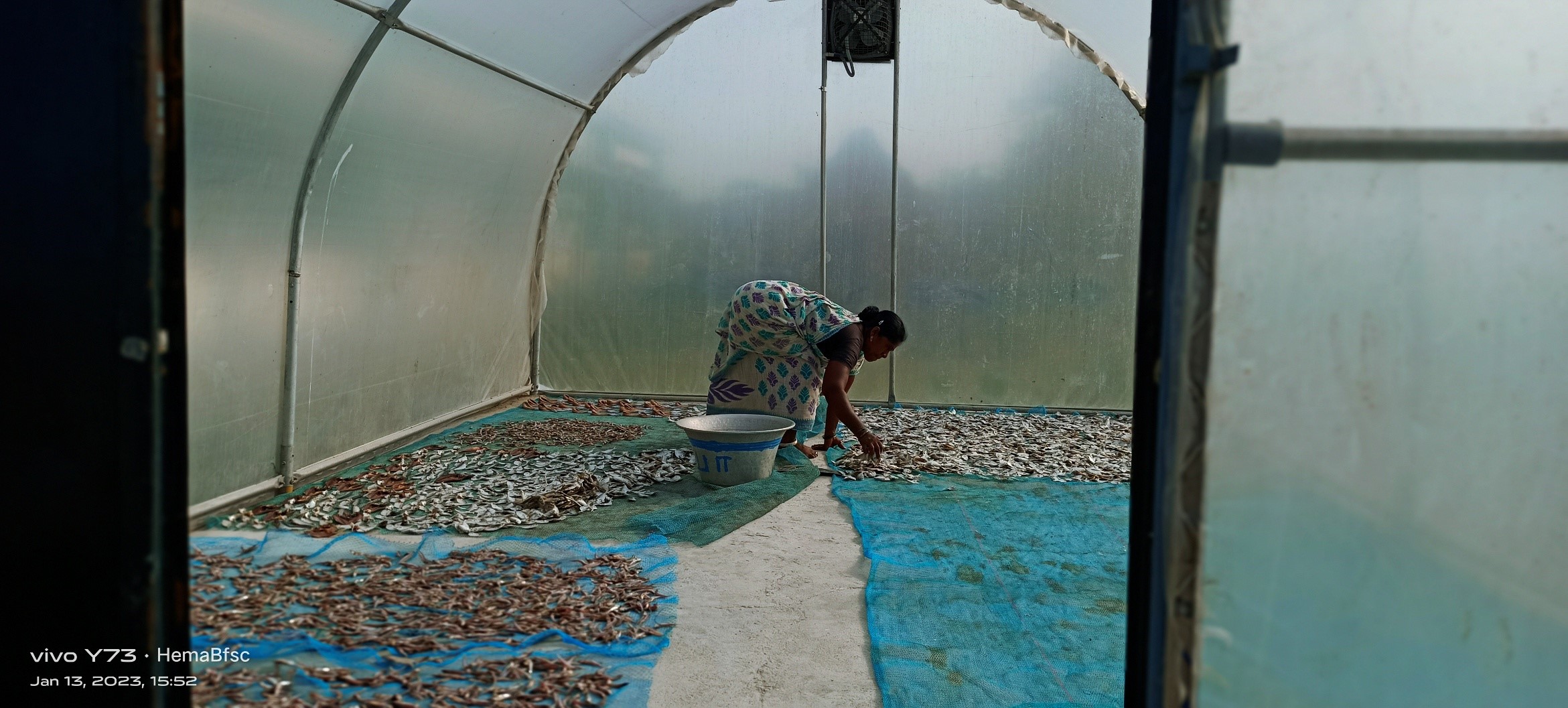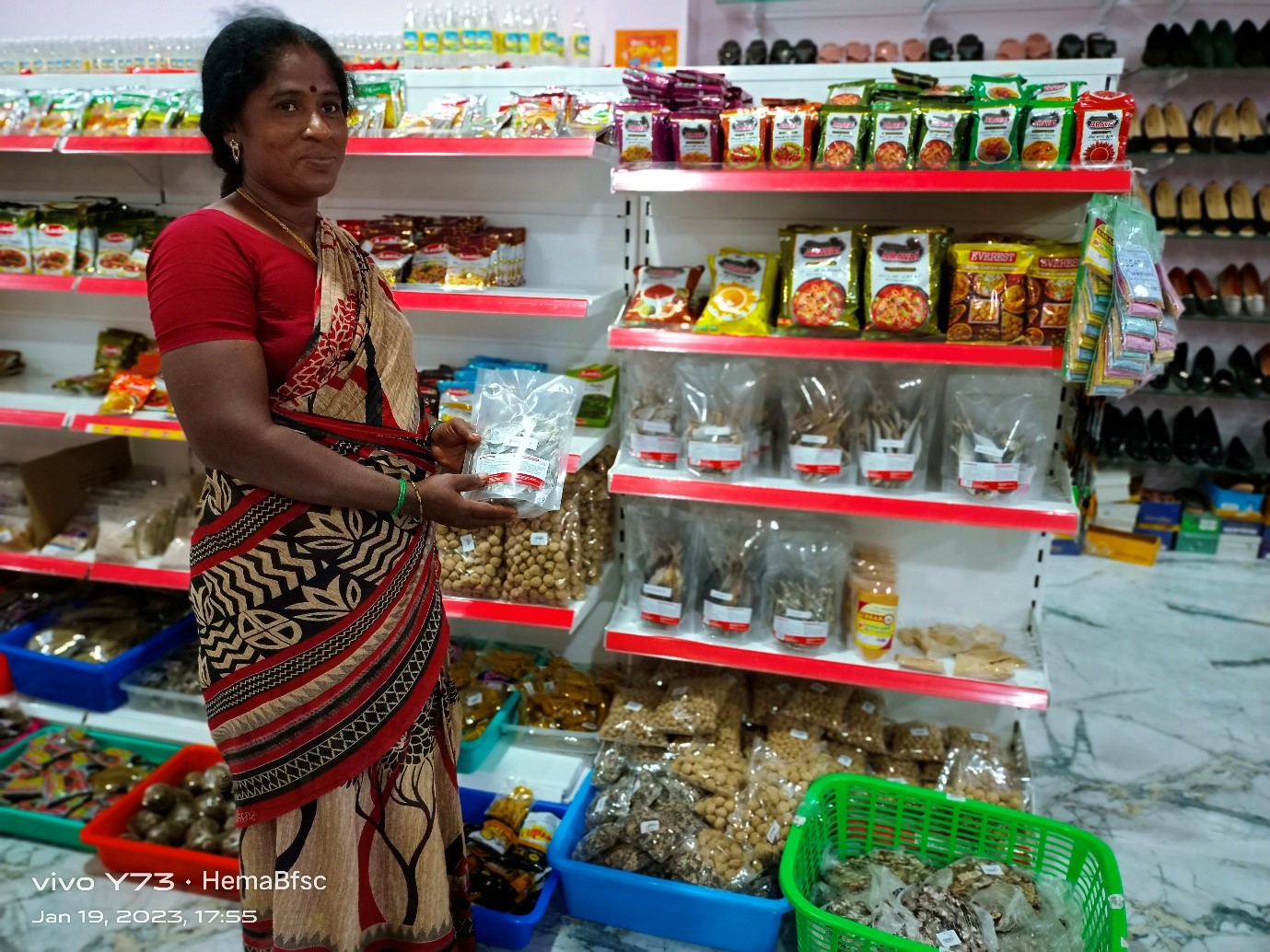From Traditions to Triumph – Sathya’s Success in the Dry Fish Business
Sathya, a 45-year-old resident of the serene fishing village of Mudasolodai in Cuddalore district, faced numerous challenges in her dry fish business. Engaging in the traditional open sun-drying Methods, she struggled with quality issues, limited profit margins, and a lack of knowledge of proper processing techniques. Her reliance on outdated practices and uncertainty in pricing further hindered her ability to compete in the market. Despite her efforts, her business remained confined to local markets, with limited access to larger consumer bases, leading to frequent losses due to the short shelf life of her products.
Sathya's traditional open sun drying methods often resulted in inconsistently dried fish with varying moisture levels, which compromised the quality and shelf life of her products. The inefficiencies of this traditional drying process, combined with market fluctuations and a lack of knowledge of proper pricing strategies, led to minimal profit margins for Sathya and her fellow dry fish vendors. Moreover, without a comprehensive understanding of modern processing techniques—such as effective drying, packaging, sealing, and labeling—Sathya's product quality remained suboptimal, limiting her success in the market.
Her dependency on outdated, age-old practices also restricted the competitiveness of her products. Determining appropriate prices for her dry fish was another challenge, often leading to the undervaluation of products and reduced profitability. Furthermore, Sathya's business was confined to local markets, particularly in Parangipettai village, preventing her from reaching a larger consumer base and stunting her business growth. The short shelf life of her products, a result of the traditional drying method, frequently caused losses due to product deterioration, especially during adverse weather conditions.
The turning point in Sathya’s business came when the M.S. Swaminathan Research Foundation (MSSRF), in collaboration with NABARD under the Gram Vikas Nidhi initiative, introduced a comprehensive set of interventions. One of the key changes was the introduction of solar dryers, which provided a controlled environment for drying fish, significantly improving the quality and consistency of her dried products.
Additionally, MSSRF conducted hands-on demonstrations and training sessions, equipping Sathya and her community with essential skills in modern processing techniques, including effective drying, packaging, sealing, labeling, and setting appropriate prices for their products. MSSRF also played a crucial role in expanding market linkages, enabling Sathya to transition from selling solely in local markets to supplying supermarkets in Perangipettai, Mutlur, and Neyveli, and even receiving orders from distant locations. Furthermore, MSSRF encouraged the use of attractive packaging, which enhanced the market appeal of Sathya's products and enabled her to secure premium pricing.
The adoption of solar drying significantly improved the quality of Sathya’s dry fish products, ensuring complete drying with zero moisture content, enhancing both taste and texture and increasing consumer satisfaction. This shift to solar drying, combined with guidance on pricing strategies, resulted in higher profit margins for Sathya. The improved drying process allowed for higher selling prices and better profitability. With the enhanced quality of her products, the price of dried fish, particularly anchovy, increased from Rs 250-300 per kilogram to Rs 500 per kilogram, reflecting the improved market value.
MSSRF's efforts in expanding market linkages also enabled Sathya to diversify her business by supplying supermarkets across the Cuddalore district and beyond, significantly increasing her customer base and overall sales. Consumer recognition of her products grew as well, with the improved quality, attractive packaging, and premium pricing resulting in higher demand and greater perceived value. The solar drying process also extended the shelf life of her products to over six months, which significantly reduced losses and enabled better stock management. "Before, I struggled to sell my products beyond my village. Now, my dry fish is in supermarkets miles away, and customers call me directly for orders. This was once unimaginable," Sathya shares with joy.
The overall impact of MSSRF’s interventions led to economic empowerment for Sathya and her community, as they transitioned from struggling with low profits to thriving in a competitive market, ultimately improving their livelihoods. Armed with new knowledge and modern techniques, Sathya and her fellow dry fish vendors are well-positioned for ongoing success. Creating an online presence through social media or a website could further expand their reach and attract more customers. Obtaining quality certifications and collaborating with other local businesses could open new growth opportunities. By leveraging their newly acquired skills and market connections, they can continue to thrive in the dry fish industry while contributing to the sustainability and economic growth of their community.

